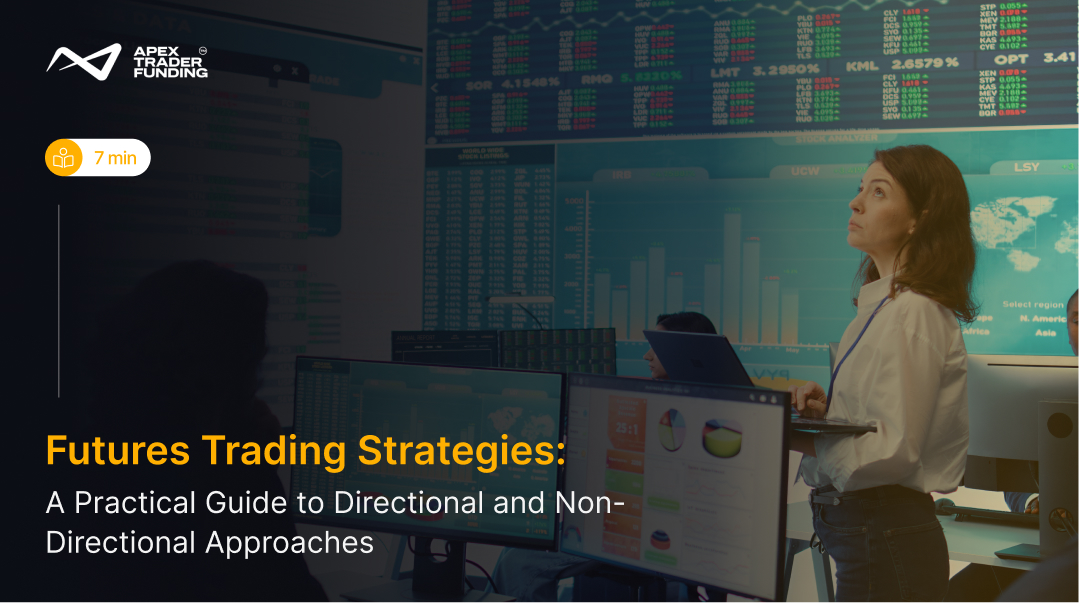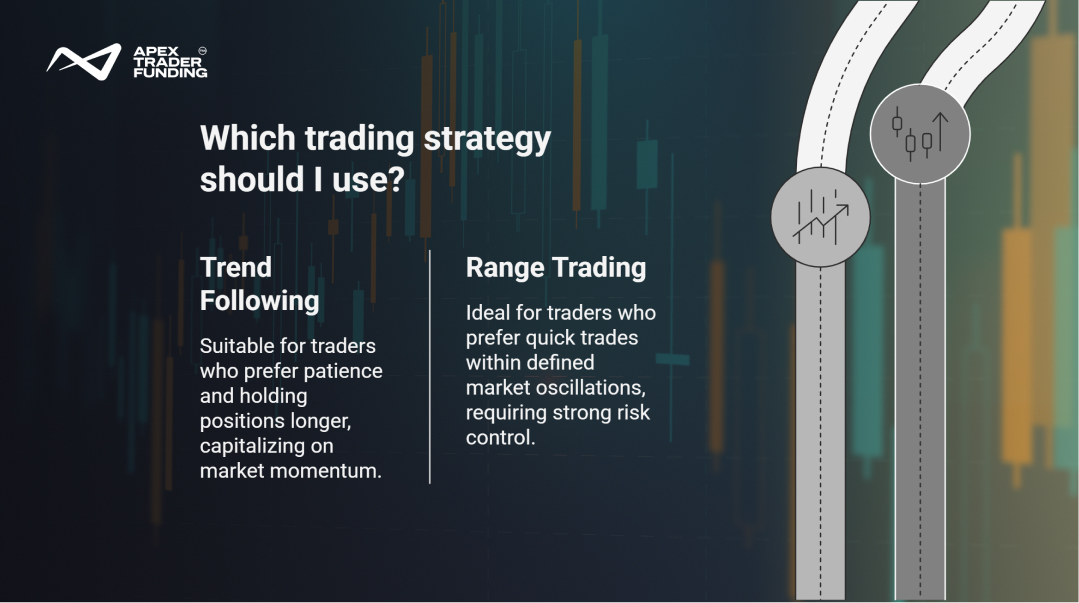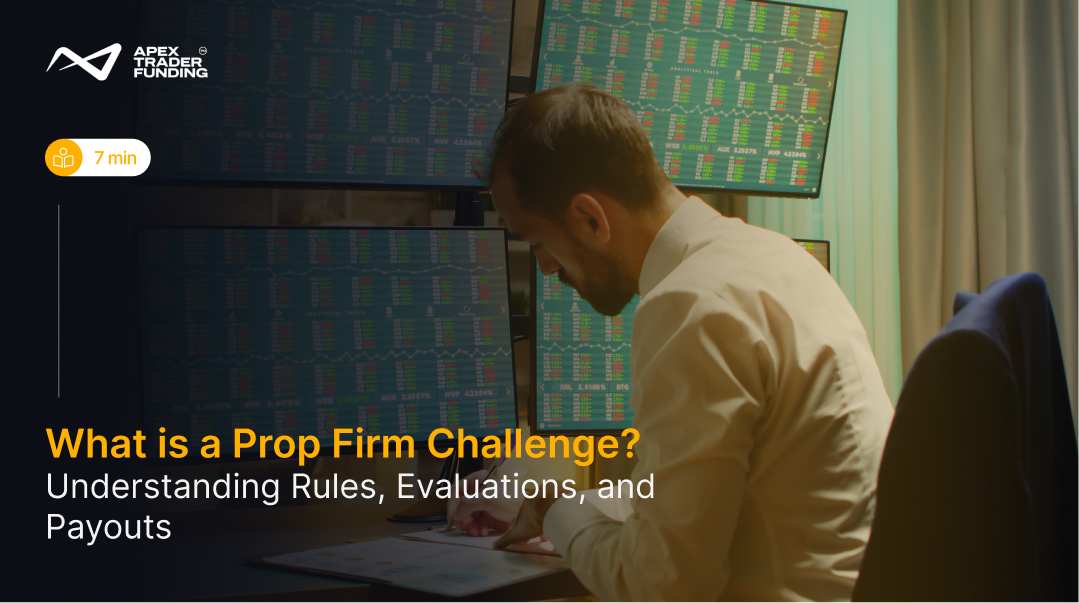
trading-strategies | 06-10-25
Futures trading attracts traders worldwide because it offers leverage, liquidity, and opportunities in everything from commodities to equity indices. Yet profitability depends less on luck and more on applying the right strategy at the right time.
In futures trading, strategy is not about predicting the market perfectly, but about preparing for what the market might do next.
Broadly speaking, futures trading strategies can be divided into two categories:
- Directional strategies: betting on whether prices will rise or fall.
- Non-directional strategies: profiting from spreads, hedges, or inefficiencies without relying on the outright direction of the market.
Understanding this distinction is the first step to choosing the methods that fit your personality, risk tolerance, and trading goals. Below, we explore eight proven strategies that traders use to navigate the futures markets.
1. Trend Following
One of the most popular directional strategies, trend following, assumes that once a market begins to move in one direction, it’s likely to continue.
- How it works: A trader identifies a strong upward or downward trend, often using moving averages or momentum indicators. Long positions are taken in uptrends, short positions in downtrends.
- Why it works: Trends are fueled by collective market psychology — once institutions and retail traders align, momentum can carry prices for days or weeks.
- Best for: Traders who prefer patience and are comfortable holding positions longer.
2. Breakout Trading
Breakout traders aim to capitalize on explosive moves when the market leaves a consolidation zone.
- How it works: The trader identifies key support or resistance levels. When price breaks through these zones on strong volume, they enter in the direction of the breakout.
- Why it works: Breakouts often signal a new phase of market sentiment, where volatility creates opportunities for quick gains.
- Best for: Day traders or swing traders who thrive in high-volatility conditions.
3. Pullback Trading
Pullback trading allows traders to join a trend without chasing the market.
- How it works: After identifying an uptrend, the trader waits for a temporary dip back to a support level before entering a long trade. In a downtrend, they wait for a bounce to resistance before shorting.
- Why it works: Pullbacks give better entry prices and often come with a tighter stop-loss, improving the risk-reward ratio.
- Best for: Traders seeking precision entries while following established trends.
4. Range Trading
Not all markets trend — many move sideways within defined ranges. Range trading exploits these conditions.
- How it works: The trader buys futures near support levels and sells near resistance levels, repeating as long as the range holds.
- Why it works: Market indecision often creates predictable oscillations between levels.
- Risk factor: A breakout from the range can quickly turn profitable trades into losses, so risk control is vital.

5. Multi-Timeframe Confirmation
This strategy improves accuracy by analyzing the same market across different timeframes.
- How it works: Use a higher timeframe (e.g., 4-hour chart) to spot the overall trend. Then use a lower timeframe (e.g., 15-minute chart) to fine-tune entries that align with the larger trend.
- Why it works: It filters out false signals from “noise” on smaller timeframes and helps traders avoid fighting the broader market direction.
6. Spread Trading
Spread trading falls under non-directional strategies and is considered lower risk compared to outright bets on direction.
- How it works: Traders simultaneously buy one futures contract and sell another. This could be:
- Intra-market spread: the same asset but different expiry months (e.g., crude oil March vs. April contracts).
- Inter-market spread: two related assets (e.g., crude oil vs. heating oil).
- Why it works: The goal is to profit from changes in the relationship (spread) between contracts, not the absolute price.
- Best for: Traders who want steadier exposure with less directional risk.
7. Hedging with Futures
While hedging is more common for institutions, individual traders can use it strategically.
- How it works: Use futures to offset risk in another position. For example, a stock portfolio holder can short index futures to protect against a market downturn.
- Why it works: It reduces exposure to sudden adverse moves while keeping the core investment intact.
- Best for: Risk-averse traders or those with large holdings in correlated markets.
8. Arbitrage
Arbitrage is one of the most advanced non-directional strategies, relying on speed and precision.
- How it works: Exploit price discrepancies across markets or contracts — for instance, buying a futures contract in one market and simultaneously selling it where it trades slightly higher.
- Why it works: Small mispricings can be captured repeatedly for consistent gains.
- Best for: Professionals or firms with access to high-frequency trading systems.
Transitioning Between Strategies
One of the biggest mistakes new futures traders make is assuming they must stick to a single strategy no matter what the market is doing. In reality, the most successful traders know when to adapt. For example, a trend-following strategy might work well in a strongly directional market, but once price action flattens into a range, switching to range trading or spread strategies often makes more sense.
The key is not to abandon discipline but to recognize that market conditions change. Futures contracts respond differently during high volatility, quiet consolidations, or news-driven events. Traders who learn to adjust their approach while keeping their core risk management rules intact develop resilience — a skill just as important as any single strategy.
Consistency in applying a strategy will outlast any single trade — discipline turns futures trading into a profession, not a gamble.
Final Thoughts
Futures trading strategies are not one-size-fits-all. A beginner may find success with simple approaches like trend following or pullback trading, while experienced traders might explore spreads or arbitrage. What unites all profitable strategies, however, is discipline, risk management, patience, and the ability to stick to a plan.
The profitability of futures trading doesn’t come from guessing the market’s next move — it comes from matching the right strategy with the right conditions and executing it consistently. To explore funding opportunities and professional trading tools, check out Apex trader funding’s website along with options like the 25K WealthCharts and 25K Rithmic accounts.
FAQs
The best time to trade futures often depends on the specific market, but generally, the most active periods are when volume and volatility are highest. For U.S. futures like the S&P 500, Nasdaq, or crude oil, this typically means the overlap between the U.S. and European market hours — roughly from 9:30 AM to 11:30 AM ET and again from 2:00 PM to 4:00 PM ET. These windows offer tighter spreads and more trading opportunities. For commodities and global contracts, traders should also align with the primary exchange hours of the underlying asset to maximize liquidity.
Trading futures correctly starts with discipline and preparation. A trader should always begin with risk management — setting stop-loss levels, sizing positions responsibly, and never risking more than they can afford. The next step is to follow a structured strategy, whether it’s trend following, breakout trading, or spread trading, and to stick with it rather than chasing random moves. Using professional platforms like Rithmic, Tradovate, or WealthCharts can help improve execution and tracking. Most importantly, consistency matters more than one big win — small, steady gains combined with strict rule-following are what define long-term success in futures trading.
Futures markets are often viewed as leading indicators because they reflect traders’ expectations of future prices. For example, index futures like the S&P 500 E-mini often move before the stock market opens, giving insight into sentiment for the day ahead. Traders also watch commodity and interest rate futures to anticipate trends in inflation, currency moves, or economic growth. While futures can signal potential direction, they are not guarantees — combining futures price action with technical analysis and risk management is the best way to use them as a predictive tool.
Related Blogs

trading-strategies | 27-08-25
How Do Funded Trading Accounts Make Money?
The idea of trading with someone else’s capital has opened doors for thousands of aspiring market participants. Funded trading accounts...
Read more
trading-strategies | 11-09-25
What is a Prop Firm Challenge? - Everything You Need to Know
For aspiring traders, one of the most common gateways into proprietary trading firms is the prop firm challenge. It’s a structured evaluation...
Read more
trading-strategies | 03-10-25
7 Best Prop Trading Firms in Mexico in 2025
Trading in Mexico has evolved into more than just a search for market opportunities — it has become a test...
Read more